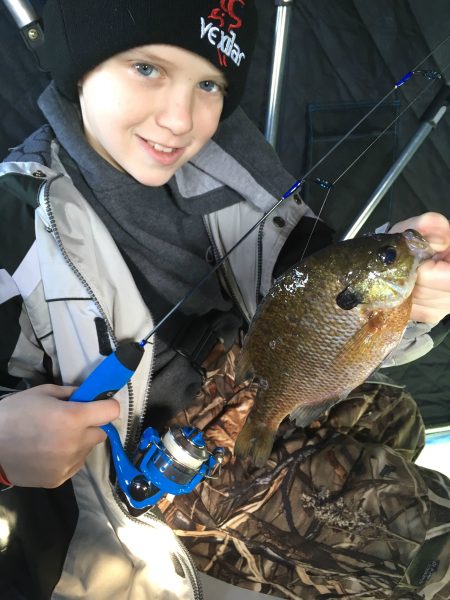Field Test: Vexilar FL-20 and FL-18 Flashers
Dave Maas 12.08.17

Because I’m an avid whitetail bowhunter, I often don’t experience early ice for panfish, which in my home state of Minnesota, means late-November and early December (right now!). Most years, I chose trophy bucks over trophy bluegills – simple as that. However, if I’m lucky enough to fill my deer tag early, which I did this year on November 10, that opens the door to pursuing first-ice panfish.

That Was Then, This Is Now
I began ice fishing seriously in 1987. That fall/winter I invested in a Fish Trap ice shelter and a Si-Tex FL-7 flasher, which was transported in a Dave Genz “Ice Box.” I attached the FL-7’s transducer to an aluminum hunting arrow (below) to minimize surface clutter on the flasher, and for 30 years the system has been deadly. Unbelievably, the flasher stills runs like new, and I changed the battery once in 30 years! How that’s possible, I’ll never know.

During the winter of 2016/2017, my two sons, ages 12 and 14, began ice fishing with me more often, and being a “one flasher family” simply wasn’t going to cut it. I don’t want to overstate this, but there are few things in life worse than ice fishing for panfish without a flasher. And while we tried cutting three holes close enough together so we could spot all three of our ice jigs on the FL-7 simultaneously, the head-butting quickly got old and we needed a change.
After careful research, I chose to add two new Vexilar flashers to our arsenal. Specifically I went the FL-20 ProPack II with the 12 degree Ice-Ducer, and the FL-18 ProPack II with the 12 degree Ice-Ducer.

The housing of FL-18 looks similar to my FL-7, and it operates in much the same way, but in terms of performance, it’s not a close contest. From the FL-18’s three colors vs. the FL-7’s one color, to the ability of the FL-18 to zoom on the bottom 6 feet, the new unit outperformed my ancient flasher on panfish all winter long. And during March 2017, when the bluegills were shallow, the FL-18’s Low-Power Mode worked like magic for keeping a clean screen while still seeing your jig and fish. My youngest son, Luke, adopted the FL-18 as his own.

The FL-20 (below) has a flat-screen, and while I was skeptical about seeing the signals without a flasher housing/hood like my FL-7 or the FL-18, I can state plainly that it works extremely well. The flat screen is easily viewed from any angle, and all the trouble with getting snow, sleet or Eurolarve dust (how does that happen?!) caught in the hood of a flasher are gone with the FL-20.

In addition to having all the great features of the FL-18, the FL-20 has two bottom zoom ranges: 6 or 12 feet. I witnessed this first hand: when crappies are deep but suspended, say 10 feet off the bottom in 35 feet, the FL-20’s dual zoom range is a game-changer. My oldest son, Elliott, adopted the FL-20.

Let me also discuss the ProPack II for each unit. Because the pack slips easily into the bottom of a 5-gallon pail, the flasher is protected during the journey to and from the lake. The patented Ice-Ducer float system with the self-leveling transducer works perfectly every time, and when you hook a big fish and want to quickly get the transducer out of the way to avoid a possible tangle, it’s easy to remove. This is NOT the case with my DIY arrow system on my FL-7.
Another added bonus on the ProPack II is the handy tackle box that’s included. FYI: The FL-18’s tackle box says “Luke” in permanent black marker, and the FL-20’s box says “Elliott.” That wasn’t my idea . . . but what are you going to do?

Our family very much looks forward to using the FL-20 and FL-18 this upcoming weekend as we begin our 2017/2018 winter fishing season. Last winter we released more big bluegills than ever before thanks to top-notch technology on the ice, and keeping a few fish for meals was a welcomed bonus, too.
Chances are good that this winter I’ll retire my FL-7 and get a Vexilar FLX-28 for me and me alone. The first thing I’ll do is find the permanent black marker and write “Dad” on the included tackle box!

